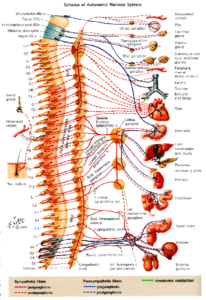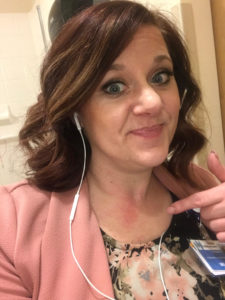Even though my body is paralyzed from my upper waist down, and I have no function or feeling below the level of my injury, my body still has its own way of alerting me when something is wrong. A lot of systems are controlled by the autonomic nervous system. So, before I talk about listening to my body, we should understand what we are controlling.
What is the autonomic nervous system?
The autonomic nervous system is the part of the nervous system responsible for control of the bodily functions not consciously directed, such as breathing, the heartbeat, and digestive processes. It’s the part of the system that controls the “flight-or-fight” response. So, if your body detects something wrong, or thinks something is wrong, warning signals go off.
 As you are probably aware, as a spinal cord injury, we have to be aware of autonomic dysreflexia, or AD for short. AD is a potentially life-threatening medical emergency when your involuntary nervous system overreacts to stimuli. I have heard in the past, and everything that I’m reading says that it affects people with SCI at an injury level of T6 or higher. However, I just listened to a lecture that our SCI doctor was giving to med students, and he said something different, and I really liked how he put it.
As you are probably aware, as a spinal cord injury, we have to be aware of autonomic dysreflexia, or AD for short. AD is a potentially life-threatening medical emergency when your involuntary nervous system overreacts to stimuli. I have heard in the past, and everything that I’m reading says that it affects people with SCI at an injury level of T6 or higher. However, I just listened to a lecture that our SCI doctor was giving to med students, and he said something different, and I really liked how he put it.
He stated that anyone with a SCI can experience AD, no matter the injury level. HOWEVER, the T6/7 levels and above are where most of the nervous system controls are located. So those with lower than T7 levels are not as likely to experience AD because they have control over most of the systems. There are even reports of persons with SCI at level T10 experiencing AD.
What?!
The symptoms of autonomic dysreflexia are a pounding headache, hypertension or high blood pressure, a very slow pulse or sometimes a very fast pulse, apprehension or anxiety (sometimes people say they ‘just don’t feel right’), changes in vision, nasal congestion, sweating, flushed skin, goose bumps, tingling and pupil dilatation. Below the level of injury, your body might be clammy or you might have chills. You can have one of these symptoms, a few or all of them. The most common is a pounding headache but not everyone has this symptom. Not all individuals with AD will have a dramatic symptom. Some people have just a slight headache or none at all but they will have other symptoms.
The diagnosis of autonomic dysreflexia is made when your blood pressure, which is controlled by the autonomic nervous system, becomes 20-30mmHg over your typical normal systolic blood pressure. This is the top, or first, number. Since individuals with spinal cord injury typically run lower blood pressures, if you are 20-30mmHg higher, you might be in the normal adult blood pressure range. A general “normal” blood pressure for those with SCI tend to be around 90/60. It is important to know what your personal blood pressure normally averages so you can inform health professionals if your blood pressure is now high due to AD.
What causes AD?
The most common cause of AD is bladder or bowel distension. If the bladder is over filled or an indwelling catheter is kinked or the bowel is impacted, an episode of AD can be set off. Treatment is effective by removing the trigger such as unkinking the catheter, performing intermittent catheterization, manually removing impacted stool. Some individuals are very sensitive to any form of constriction such as a leg bag that is too tight around the calf. It may be lose when put on but might get tight during the day due to the bag filling with urine. Wrinkles in sheets has been known to set off an AD episode. Some individuals are so sensitive that even a light air current can trigger it. As technology develops, there are new stimulations of AD episodes. Computer monitors and TV glare have been more recent causes for AD episodes.
Now that we have that covered…
I started this blog post out by talking about how listening to your body can help with maintaining a healthy life. I believe that the more in tune with your body you are, the healthier you can be. Everytime my bladder is full, I get goose bumps, a red rash on my chest, as well as a few other signs. This is a form of AD, mild, yes, but still a form of AD. The sooner I realize what is going on in my body, the sooner I can relieve it. And, the sooner I go, the less likely I am to get side effects, like incontinence, from waiting too long.
The same is true with other functions of the body. I remember conversations that I’ve had with my mother saying that something must be wrong because I just don’t feel “right.” Further investigation would then lead me to the answer, and I can work on fixing whatever it was that was not right.
I urge you to start listening to your body. Take note of how you feel, your body temperature, whether you have a headache, or not, or any red patches on your body. These just might be clues that something is going on inside our bodies and we need to take care of it. Some of these signs might be faint, so you might have to really pay attention. And, I promise, in time, this will become natural and you will notice new signs or symptoms. If it helps, record signs and symptoms until you see a pattern, or get used to a certain symptom. Remember, our life is a journey and the more we know, the better we can do!
As always, leave me some feedback either here, below this post, e-mail me (megs@thewheellifeblog.com), or on any of my social media platforms! (FB/IG/TW @wheellifeblog and Snapchat @megsh8). I would love to hear from you and what I can do to help.
Let’s Grow and Grind!

Megs
Thanks to the wonderful guide
Thank you
Howdy! This post couldn’t be written any better! Reading this post reminds me of my good old room mate! He always kept talking about this. I will forward this article to him. Pretty sure he will have a good read. Thanks for sharing!
Thank you! I hope this benefits him!
Thanks, it is very informative
Thanks for the terrific post
Thank you for the excellent article